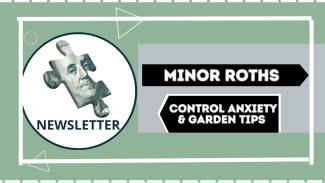
Minor Roths, Control Anxiety and Garden Tips
Roth IRAs for Kids
I recently received an email from a client asking what investment account I would recommend for their two minor children. The answer to that always depends on the intended use of the money. His answer was to give them a jumpstart on retirement savings. If that is the case, a Minor Roth IRA is hard to beat. I don’t know of a child that is in need of a tax deduction, so a Traditional IRA in my opinion would not be the best choice. A Roth IRA allows the parents or child to contribute up to $7,000 in 2025. To qualify for a Roth the child must have earned income, but income” can come in the form mowing lawns, helping neighbors with chores or part time employment.
Suppose a parent helped a child contribute $7,000 per year to a Roth IRA for just five years and let the account grow for the next 45 years. With a compounding growth rate of 8%, the child would have over 1.1 million dollars, tax free at the end of 45 years. When the child is under 18, a parent or guardian would be listed on the account until the child becomes 18. The child would have penalty free access to the principal of the Roth IRA at any time. After age 59.5 the growth of the account can be withdrawn tax free.
Roth IRAs can be invested as conservative or aggressive as the account holder desires. The above calculation of an 8% compounding growth rate is just an example and not specific to Roth IRAs. Returns are based on the investments inside the Roth IRA.
Time Tested Tomato Planting
Homemade salsa and tomatoes with basil, mozzarella cheese and balsamic are common in the summer at the Crosby household. Continuing our garden season trend, below are a few tips for growing great tomatoes. Adjust planting season based on your geographic location.
Planting: In Ohio, we begin planting our tomatoes in the last week of May. Many gardeners use Memorial Day as the kickoff to the tomato season. Rich, loose soil that drains well is a great start. Tomatoes thrive in the presence of nitrogen, phosphorus and calcium in the soil. You can buy special tomato fertilizer at any garden shop. Crushed eggshells, manure and rock phosphate will also provide these building nutrients.
Depth: Tomatoes can be planted deep, almost up to the highest leaves. Roots will grow from the buried stem which encourages root development and a larger harvest.
Weeding: Regular weeding will help the tomato plants grow. Weeds tend to compete for nutrients and can also crowd the tomato plants if left unmaintained. Some gardeners will put a layer of mulch to prevent weeds from growing. I have seen others surround the base of the plant with crushed eggshells. The sharp edges of the shells may deter slugs.
Pruning: Proper pruning of tomato plants will help keep the plant healthy and producing. Removing “Suckers” which are leaves that tend to grow where the stem and branches meet will encourage nutrients to be directed to the tomatoes instead of new leaves. Here is a video on how to prune a tomato plant.
Watering and Light: Tomatoes prefer plenty of light, at least 6 to 8 hours of direct sunlight. The soil should be moist but not soggy. Try to water the base of the plant to avoid fungus growing on the leaves.
We’d love to receive pictures of your garden this summer!

Control Repetitive Thoughts
Anxiety can arise from our brains trying to process too much information at one time. Many students may have experienced this firsthand with finals and graduation. As we grow older the amount of responsibility increases and so does the demand on our brains.
Meditation and trigger phrases can assist. Let me explain: A mentor of mine once told me the secret to success is to focus on what can be controlled and let the rest go. This by itself, if it can be practiced, will reduce the amount of information your brain has to process. Studies show people may have more than 6,000 thoughts running through their minds over the course of a day. What is more astonishing is that researchers say as much as 80% of those thoughts can be repetitive self-talk. Have you ever driven to work having a conversation in your head about a disagreement you had with a relative, coworker or friend, or solving the problem of an event that hasn’t happened? Of course, we all have. Emotional intelligence is the ability to become aware of the emotions we are feeling and what is causing them. If the brain is allowed to run wild, we tend to stress ourselves out through repetitive thoughts on topics that are largely out of our control.
The next time you notice thoughts running through your head like hamsters on a wheel, take a moment to clear your mind and take a few deep breaths. Remind yourself to give attention to only things that are in your control. If you do that, you have a much better chance of the future turning out in your favor. Meditating for just a few short minutes is a fantastic tool for accomplishing this. I often use a phrase to realign my thoughts. The phrase is simply the next goals I want to achieve. I’ve done this so much the goals themselves aren’t what’s important but simply taking a few breaths and repeating the phrase reminds me to let go of destructive thoughts and focus on what I can control.
*This technique is from personal experience and should not replace recommendations from a licensed medical professional.
Disclaimer: Crosby Advisory Group, LLC is a registered investment advisor. This newsletter is for informational purposes and does not reflect direct investment or tax advice. Investing involves risk including the potential loss of principal. Not all investments are suitable for all people. Crosby Advisory Group, LLC has ownership interest in NMD Insurance Agency and CAG Marketing.

